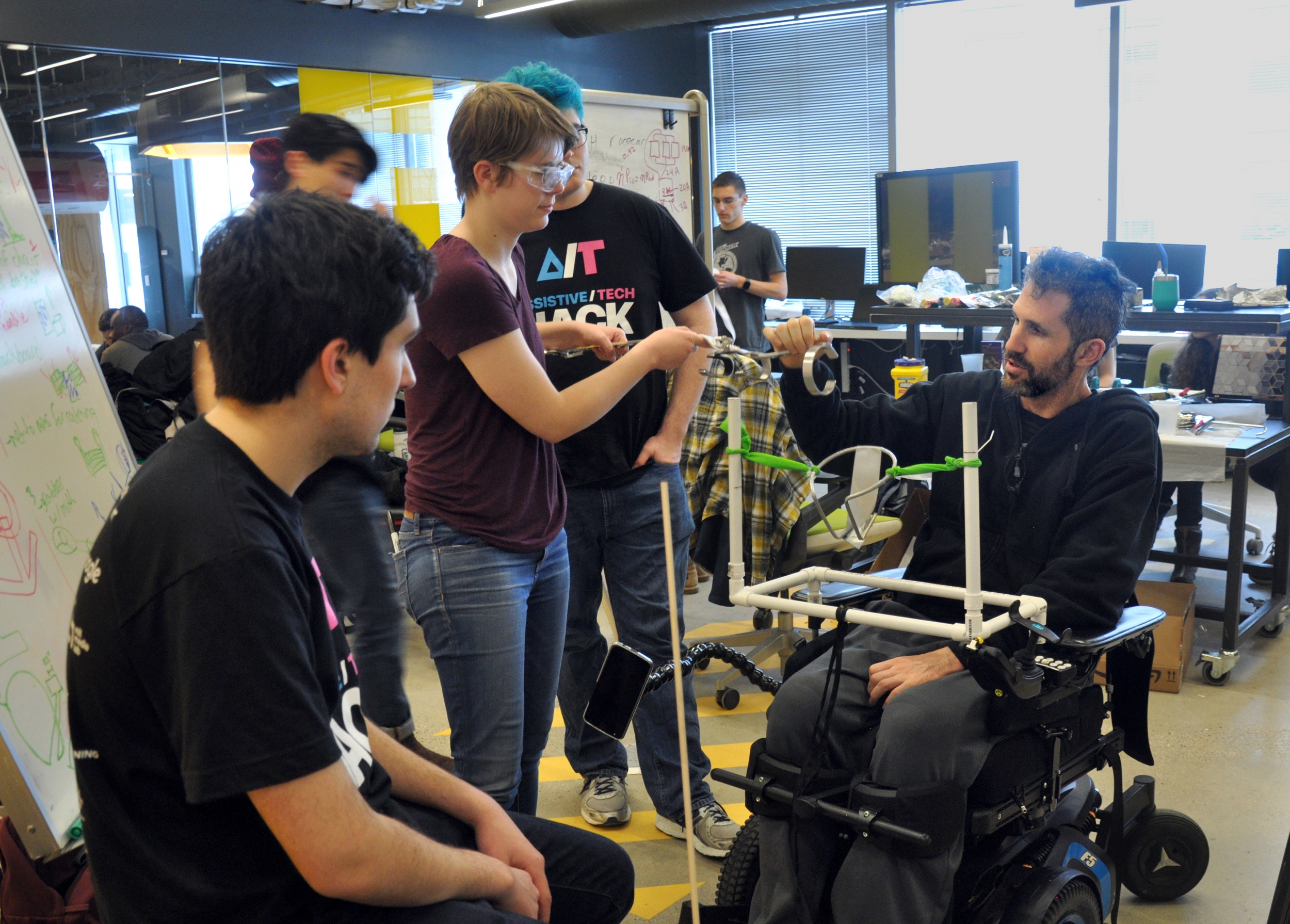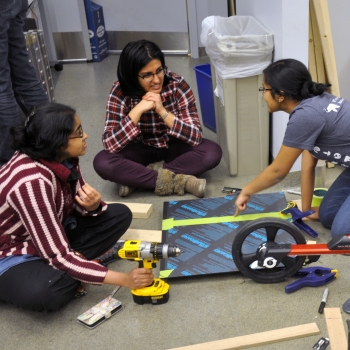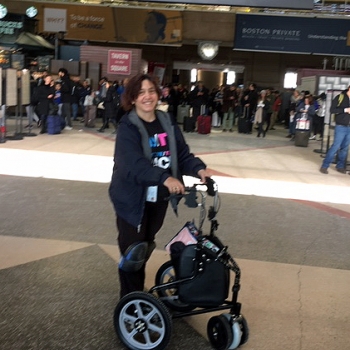Sixth annual MIT ATHack develops technology for Bostonians living with disabilities
Lora Brugnaro says to think of her like a Weeble Wobble toy that constantly falls down. She has cerebral palsy, which severely impacts her balance, and has used a walker to help her stay upright while moving around for years. Unfortunately, she has found that walkers available on the market are cheap, unstable, and prone to flipping on rough surfaces, leaving her sprawled out on the floor of the T or in the middle of the street. She had even started considering using a wheelchair to avoid such situations. "I have felt for a very long time that the daily choice I made between safety and living with the freedom to move was an unnecessary choice predicated on poor design," she said.
Brugnaro was also one of the co-designers at the sixth annual Assistive Technologies Hackathon, or ATHack. The event pairs teams of students, most but not all of whom study at MIT, with Boston and Cambridge area people living with disabilities.
Team Lora spent the hackathon working to create a more stable walker. Zoe Levitt, a member of Team Lora, walked with Brugnaro through a typical journey she takes to get from home to work and back again. Levitt observed Brugnaro's challenges and took videos to share with the rest of the team, supplementing Brugnaro's feedback. "The collaboration was the most meaningful part of the event for me," Brugnaro said. "I’ve spoken to many people about my struggles; nobody ever offered solutions or suggested there might be any. It’s depressing and demeaning when companies ignore your feedback, and medical professionals seem satisfied with the standard options." For her part, Levitt found Brugnaro's engaged collaboration instrumental in designing a product that worked; "Lora is super awesome; she had a really clear idea of a problem she needed help with and was really eager to hear our ideas," she said. "Actually, after the hackathon…she [Brugnaro] took the [ATHack designed] walker home, and on Monday I got this email with about 15 bullet points about what worked and what didn't work, and what could be improved!"

ATHack was founded in 2014 by then-juniors at MIT Jaya Narain and Ishwarya Ananthabhotla and then-senior Abigail Klein. They had previously been a part of tech projects that involved at the design stage the people who would ultimately be using the technology, and they had found the experience meaningful and valuable. They thought that other MIT students could benefit from a similar experience, and so created the ATHack to bring together community members living with disabilities and student designers. "We wanted to create a way for a lot of people at MIT to become exposed to assistive technology through the co-design model," Narain said.
Unlike much of the research and development that takes place at MIT, the solutions created by the ATHack designers are often very straightforward and even simple. To Ananthabhotla, that simplicity is a marker of success. "Unlike most other hackathons, this event is really not about building the best, 'coolest' tech," she explained. "It is about building a relationship with a community member and building the design skills needed to identify a need, understand a context, and ideate iteratively."
Narain and Ananthabhotla organized MIT ATHack 2019 with MIT alumnus Hosea Siu and student volunteers Tareq El Dandachi, Imane Bouzit, Sally Beiruti, Amanda Fike, and Samuel Mendez. Together, they set up a Meet the Co-Designers dinner on February 11, where groups of students were paired up with co-designers on the bases of skills and interests. The students had a few weeks to collaborate with their co-designer, brainstorm, and request specialized materials before the hackathon at the MIT Lincoln Laboratory Beaver Works Center on March 2. Teams were also allowed to start building before the hackathon, if they chose to do so.

Alex Rosenberg, another ATHack co-designer, uses a wheelchair, as well as having limited arm strength and lacking the ability to use his fingers. "Having just become disabled, the most difficult thing is to find time for the problem solving of everyday life problems," Rosenberg said. "The hospitals, the therapists, and family and friends take care of the major things, but picking up a cup or throwing a ball to your kids are deemed by everybody else as not important enough to spend precious time figuring out how to make easier. The hackathon is so valuable because it makes space for that time." Team Alex created a system to launch and catch a ball so that Alex could play with his two sons. They were particularly focused on making it simple enough for Alex to use it without the aid of another adult. The team came in second in the co-designer collaboration category, but more importantly, Alex has already been able to make use of the technology. "The product we created at the hackathon as a team has already brought so much joy to my relationship with my sons!" he said.
Sara Falcone was part of Team Reese. After first being introduced to him at the Meet the Co-Designers dinner, Falcone and her teammates at ATHack started designing a robust neck support brace. Reese, a teenager with cerebral palsy, has difficulty controlling his head motion, making it hard for him to use eye-tracking-based communication tools, watch TV, see the board during classes, and drive his chair. Team Reese created a pneumatic brace, which uses pressurized air to keep his head stable, to allow him and his family to control how much support he has at any given time.
"Reese was an awesome co-designer and a great person to meet; I learned a lot from him. Since he is mostly nonverbal, I was initially concerned we wouldn't be able to make something that really worked for him, but he was able to fully communicate with few words," Falcone said. "Reese has a contagious smile and laughed at all our failed first attempts, which really made us feel comfortable trying a bunch of different, goofy, often terrible ideas with him, and made for a fun day."
Winning teams were selected in four categories: usability, co-designer collaboration, technical innovation, and documentation. Team Reese came in first in the technical innovation category for their pneumatic neck brace. However, Falcone isn't satisfied yet. "I'm excited to keep working on our solution for Reese to make it a polished, durable tool for him," she said. "We ended the hackathon with a pretty solid direction, but the prototype was made in less than 12 hours, so there's a number of things we'd like to improve to make it better for Reese."
The winner in the usability category was Team Sara, who developed a portable bidet that would allow their co-designer to use the bathroom at work and in other public places. They published an Instructable on their product, so that other people can build one too. Team Phil won the documentation category with a low-cost modular stander to aid people with limited lower body control. They published an entire website, with Ikea-like instructions on how to build their modular stander they named "PhilGood". Finally, the co-designer collaboration category was won by Team Lora. Brugnaro used her improved walker on the way home from the hackathon, and every day since; she hopes to eventually bring the design to other people with mobility issues. "I no longer feel like a second-class citizen with a crappily [designed], cheap rollator that breaks apart every six months," she said. "I finally have my own personal vehicle, with a brake system that actually brakes and a wheel system that provides 100 percent stability."
Cameron Taylor, one of the designers in Team Sara, summed up why ATHack was so important. "Technologies are designed for those who fit standard parameters, leaving people who have unique physiologies technologically behind," he said. "From this economic perspective, having a unique physiology doesn’t make you disabled, it makes your technology disabled. Because the designers at ATHack do not come to the hack driven by economics, the hackathon breaks this cycle and allows technologies to be developed for people on an individual level."
Brugnaro put it even more simply: "Without this hackathon, it would have been impossible to work with people who understood the science behind my problem and proved that there is a solution. Two weeks, four bright students, and one user changed my life."

